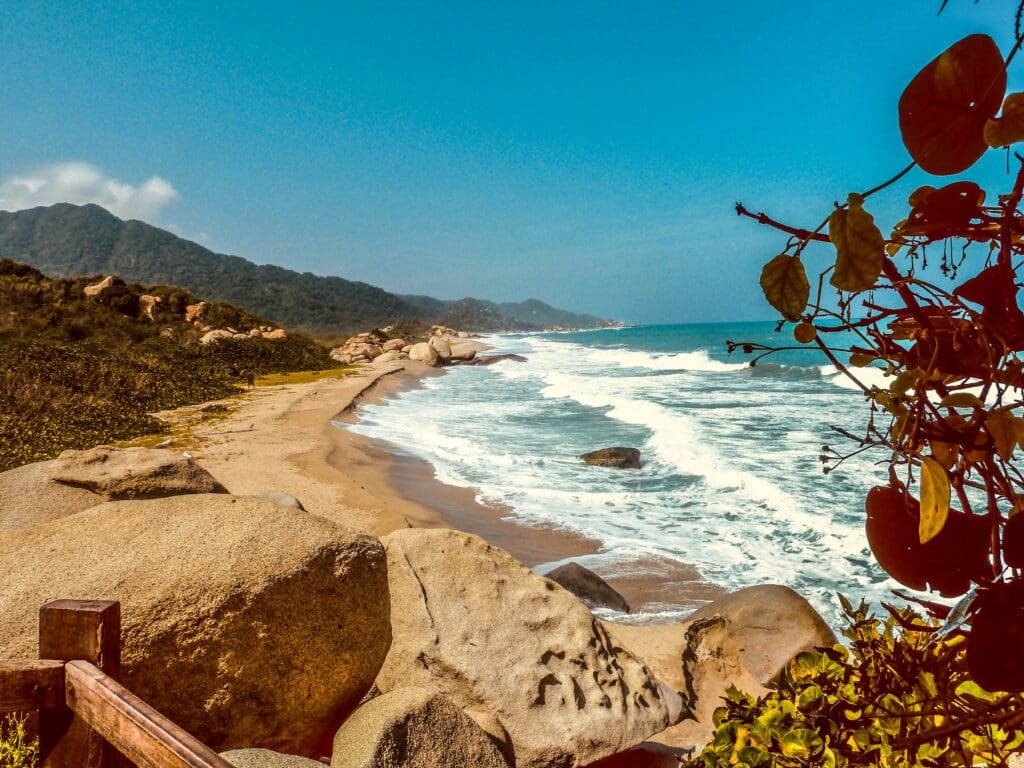Colombia
Country Name: Republic of Colombia
Capital City: Bogotá
Population: Approximately 52 million (2024 est.)
Official Language: Spanish
Currency: Colombian Peso (COP)
Time Zone: Colombia Time (COT), UTC -5




Diving Overview
Colombia offers diverse diving experiences with its Caribbean and Pacific coastlines, featuring coral reefs, shipwrecks, and abundant marine life. The country’s warm waters and rich biodiversity make it an attractive destination for divers of all levels.
- Number of Dive Sites: Over 200
- Types of Diving: Reef, wreck, drift, and wall diving.
- Marine Biodiversity Highlights: Turtles, rays, sharks, various species of tropical fish, and vibrant coral reefs.
- Average Water Temperatures: 26-30°C (79-86°F)
- Visibility Range: 10-30 meters (33-98 feet)
Important Information
Optimal Dive Seasons
The best diving conditions are typically from December to April, when the waters are calm and visibility is high.
Major Airports
El Dorado International Airport (Bogotá), Rafael Núñez International Airport (Cartagena), Ernesto Cortissoz International Airport (Barranquilla)
The Travel Tip
A 3mm wetsuit is usually sufficient for diving in Colombia’s warm waters, but consider a thicker suit for deeper dives or cooler periods.
Weather Patterns
Colombia has a tropical climate with variations due to altitude. Coastal areas are hot and humid year-round, while the Andean region experiences cooler temperatures.
Internal Transportation
Options include domestic flights, buses, and a network of taxis and ride-sharing services, providing connectivity across the country.
Attractions
Major attractions include the colonial city of Cartagena, the Coffee Cultural Landscape, Tayrona National Park, the Amazon rainforest, and the vibrant cities of Bogotá and Medellín.
Top Dive Regions
Colombia offers some of the most exciting and diverse diving experiences in South America, with its Caribbean and Pacific coastlines providing unique underwater landscapes and abundant marine life. San Andrés and Providencia are renowned for their crystal-clear waters, vibrant coral reefs, and a plethora of marine species, making them perfect for both novice and experienced divers. Cartagena combines historical shipwrecks with colorful coral reefs, offering a fascinating underwater adventure close to the culturally rich colonial city. Gorgona Island, located in the Pacific, is famous for its seasonal humpback whale migrations and rich marine biodiversity, providing unforgettable encounters with large marine animals. Lastly, Malpelo Island is a remote and challenging dive location known for its encounters with large pelagic species such as hammerhead sharks and manta rays, offering thrilling dives for advanced divers. These top dive sites highlight Colombia’s diverse marine environments and the country’s appeal as a premier diving destination.

San Andrés and Providencia
Known for their clear waters, vibrant coral reefs, and a variety of marine life, making them ideal for both beginner and advanced divers.

Cartagena
Offers historical shipwrecks and coral reefs, providing a rich underwater experience combined with the cultural allure of the colonial city.

Gorgona Island
Located in the Pacific, it is famous for encounters with humpback whales during their migration season, along with rich marine biodiversity.

Malpelo Island
A remote dive location in the Pacific Ocean, known for its large pelagic species, including hammerhead sharks and manta rays, providing thrilling experiences for experienced divers.
Marine Life
Colombia’s diverse marine environments, spanning both the Caribbean and Pacific coasts, are home to an impressive variety of marine life. The coral reefs of the Caribbean coast, particularly around San Andrés and Providencia, teem with vibrant tropical fish, sea turtles, rays, and various species of sharks. These reefs are also home to colorful corals, sponges, and an array of invertebrates. In the Pacific, areas like Gorgona Island and Malpelo Island are famous for their large pelagic species, including hammerhead sharks, whale sharks, and manta rays. Gorgona Island is notable for the seasonal migration of humpback whales, providing spectacular sightings. Additionally, Colombia’s waters host diverse species such as moray eels, barracudas, groupers, and a variety of nudibranchs and crustaceans. The unique marine ecosystems are supported by nutrient-rich waters, making Colombia a prime destination for marine biodiversity and underwater exploration.
Common Species: Sea turtles, rays, hammerhead sharks, whale sharks, manta rays, moray eels, barracudas, groupers, nudibranchs, and various species of tropical fish.
Seasonal Highlights: Humpback whales migrate through the Pacific waters around Gorgona Island from June to November, offering spectacular sightings. The best time to encounter whale sharks is typically from May to September.
-
Dive sites in Providencia Island
Situated in the Caribbean Sea, Providencia Island is part of the San Andrés and Providencia archipelago of Colombia. This island jewel is a haven for divers seeking pristine underwater experiences in an idyllic setting. Providencia’s relatively remote location has allowed…
-
Best time to dive in Providencia Island
Diving in Providencia Island offers a unique and captivating experience for scuba enthusiasts. This hidden gem, part of Colombia’s archipelago, is known for its pristine coral reefs, diverse marine life, and crystal-clear waters. Choosing the right time to dive here…
-
Overview of Providencia Island
Located roughly 800 kilometers to the northwest of mainland Colombia, Providencia Island, also known as Old Providence, is a hidden gem within the Caribbean Sea. With its cultural heritage primarily based on English, Spanish, Dutch and African customs and traditions,…
-
Dive sites in Malpelo Island
Introduction Nestled in the heart of the Pacific Ocean, off the coast of Colombia, Malpelo Island is a diver’s paradise unlike any other. Renowned for its dramatic underwater topography and the abundance of marine life, it’s no surprise that this…
-
Best time to dive in Malpelo Island
Nestled in the eastern Pacific Ocean, Malpelo Island is a mesmerizing haven for scuba diving enthusiasts. Known for its rugged underwater landscapes and abundant marine life, this UNESCO World Heritage Site offers unparalleled diving experiences. However, your diving adventure can…
-
Overview of Malpelo Island
Introduction Overview Malpelo Island, an isolated volcanic island in the eastern Pacific Ocean, is one of the most coveted dive locations for advanced divers. Located some 500 kilometers off Colombia’s Pacific coast, the island is surrounded by deep, nutrient-rich waters…



